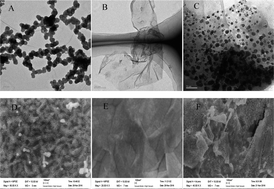An electrodeposited molecularly imprinted quartz crystal microbalance sensor sensitized with AuNPs and rGO material for highly selective and sensitive detection of amantadine†
Abstract
In the present work, a new amantadine (AM) imprinted quartz crystal microbalance (QCM) sensor sensitized by Au nanoparticles (AuNPs) and reduced graphene oxide (rGO) material was fabricated by electrodeposition in the presence of o-aminothiophenol (o-AT) by cyclic voltammetry scanning. AuNPs and graphene, with the advantages of great chemical stability, electrical conductivity, and large surface area, show exceptionally high sensitivity. The results of different modifications of the QCM sensor fabrication process were characterized using transmission electron microscopy (TEM), scanning electron microscopy (SEM), atomic force microscopy (AFM) and Raman spectroscopy. Under the optimal experimental conditions, the frequency shift of the MIP-QCM sensor showed a linear relationship with the concentration of the AM template in the range of 1.0 × 10−5 to 1.0 × 10−3 mmol L−1 with a limit of detection (LOD) of 5.40 × 10−6 mmol L−1. The imprinting factor for AM reached 7.1, the selectivity coefficient for the analogues rimantadine (RT), adamantine (AMT) and 1-chloroadamantane (CMT) were 7.3, 5.6, and 6.1, respectively. Here, a highly sensitive, selective and stable QCM sensor prepared via the imprinting approach is reported for the first time for detection of AM from animal-derived food samples.

- This article is part of the themed collection: Detection of contaminants in food


 Please wait while we load your content...
Please wait while we load your content...